Introduction

Meyer-Optik Görlitz produced a series of triplet lenses “Trioplan“, based on the Cook Triplet design from 1893, in different focal lengths after WWII. One of those lenses was the 100mm f/2.8 Trioplan, produced from 1956 to sometime at the end of 70s or beginning of 80s, when Meyer-Optik Görlitz was merged with Pentacon in the then East Germany. They stopped producing this lens because Pentacon had better 100mm lenses. It had OK center sharpness though and could produce a so-called soap bubble bokeh in certain situations. This was considered an optical defect then, which is what it is. With the advent of digital cameras, it became very popular though, and the prices went up in the used market, so popular that the company decided, for the first time in history, to revive the lens by a Kickstarter campaign in 2015. It was a successful campaign; the produced lenses were sold out quickly for about €1000 each. In 2023, TTArtisan has come up with a lens very similar to it, both in look and optical design. Let’s have a closer look at it!
Update 11/23: the lens is now also available for M-mount for $210 in the official shop
Sample Images




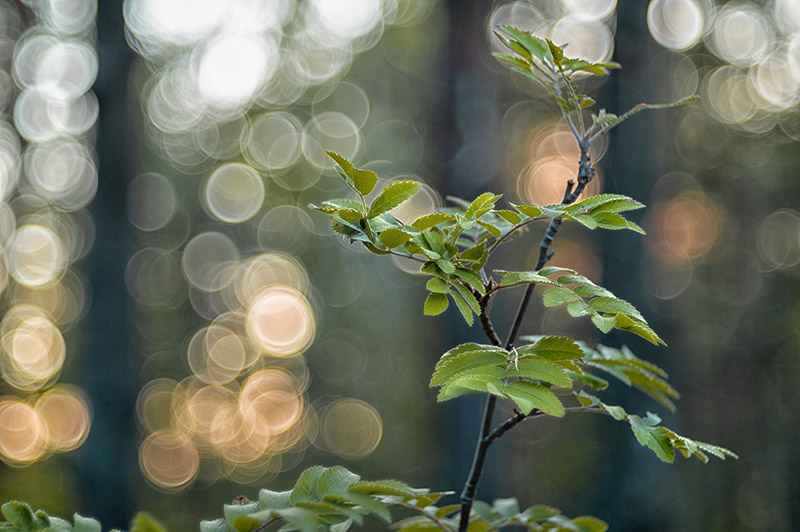
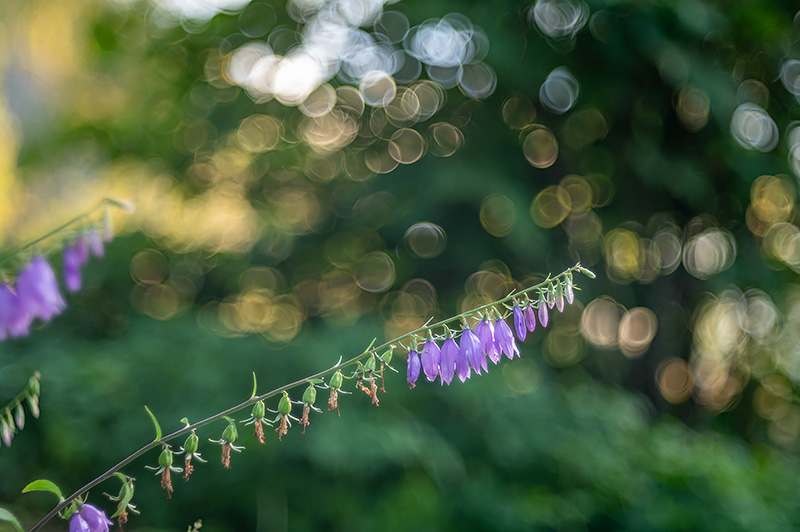
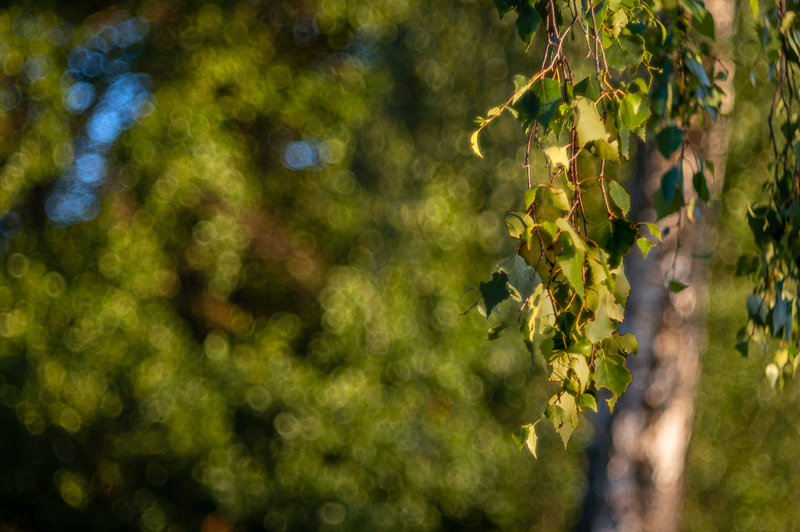

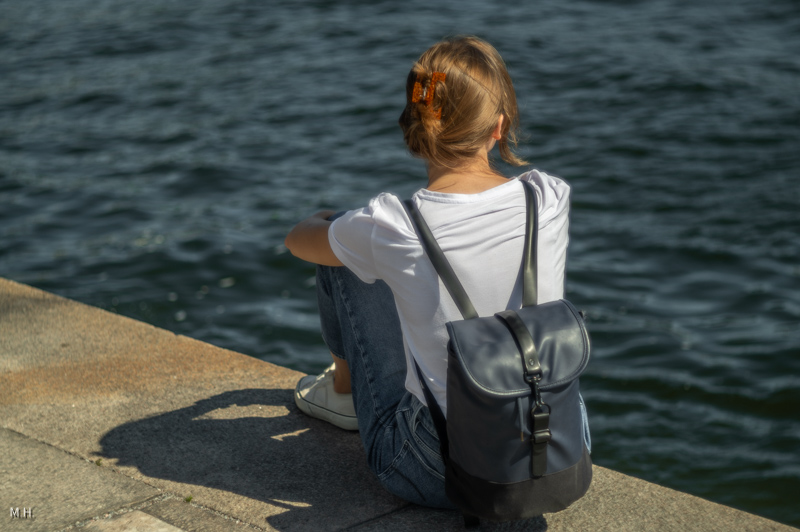

Most of the sample images in this review and many more can be found in higher resolution here.
Specifications
Focal Length: 100 mm
Aperture Range: f/2.8 – f/22
Number of Aperture Blades: 13
Min Focus: 0.9 m
Filter Size: 49 mm
Lens Mount: M42
Weight: 318g (with the metal front cap)
Diameter x Length: 58 mm x 80 mm
Elements/Group: 3/3


You can order this lens from the official homepage for $155 (affiliate link) and $210 for the M-mount version (affiliate link)
Variations
Well, this is a “new” lens and there are no variations of it but there have been others suspiciously very similar lenses. The original Meyer-Optik Görlitz 100/2.9 from 1956.

Handling
Completely manual, focus and aperture can only be set manually, no stabilization, no exif or any other info to the camera. The lens is quite small for being a 100mm, built completely of metal with engraved scale markings filled with paint for aperture values, distance (in m and ft), depth of field scale and the lens/manufacturer’s name, quite stylish and nice actually. It comes only in M42 mount and is shipped with desired mount adapter, most probably for keeping the manufacturing cost and the price as low as possible. The aperture ring has click stops at variable distance between each stop, as you go from wide open to closed aperture the distance between stops gets smaller. Between 2.8 and 11 there are click stops between each pair of full stops but from 11 to 22 there are no intermediate half stops. The aperture ring clicks smoothly and distinctly but the focusing ring has just OK resistance, not very stiff but not very smooth either. The lens cap is of metal and unlike most other lens caps screws in the filter thread, which is 49 mm. No lens hood is provided.

Optical Features
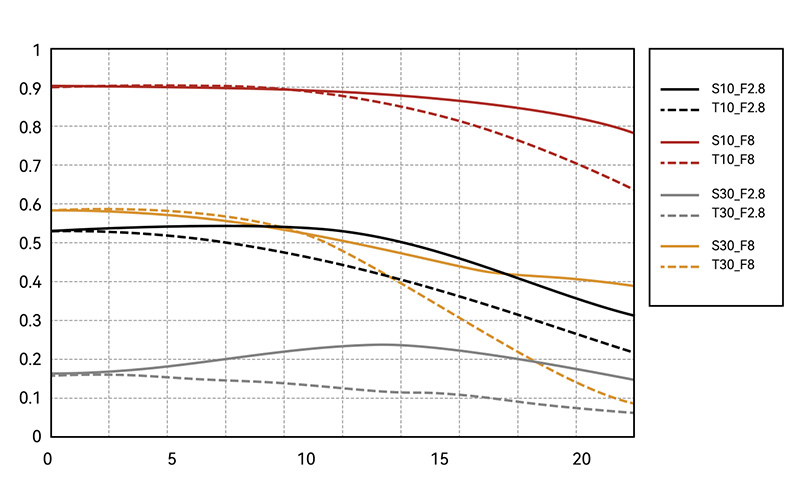
Well, just by looking at the manufacturer provided MTF chart the good things that you can read is that the lens has very good correction of astigmatism and lateral aberration in the center and out to the midframe, excellent contrast and somewhat good sharpness at f/8. There is no field curvature to expect either at any aperture. Another good thing is the sharpness and contrast, at whatever level they are, don’t fall at all to about the mid-frame and start to deteriorate just moderately from mid-frame to the corners. But you should not expect any good sharpness or excellent contrast at f/2.8, not a disaster either, possibly they are usable in real life. There is also an indication that you can get good bubble bokeh rings in the corners. All these are just indications for what could be expected with a pinch of salt and nothing more. Let’s see how it performs in real life.
Sharpness (Infinity)
For the infinity sharpness test, we look at three areas of the image, center, mid-frame and corner, see highlighted areas in the image below!


F/2.8: Center sharpness is just OK, it is usable but may need some boost in post processing, contrast is low. Mid-frame is close to center but not as good, it is usable, cornet is just bad.
F/4: Center is now completely OK and mid-frame is usable with boost in post. Corners are still bad.
F/5.6: Center now at good level, a little improvement in mid-frame, corners look better but not usable yet.
F/8: Both center and mid-frame are very good now, corners still too soft.
F/11: Center and mid-frame are still good and at last the corners reach an acceptable level.
F/16: Sharpness and contrast decreases in the center a little but still at a good level, mid-frame and corner are good.
F/22: Sharpness and contrast decrease a little more across the whole frame.
Sharpness (Portrait)
We look at the sharpness at portrait distance, for this lens about 2.4 m, at three points important for portraits, center, Inner center periphery and outer center periphery. As the lens’s widest aperture is the modest f/2.8, I tested the lens for portrait sharpness at half stops at f/2.8, f/3.3 and f/4.
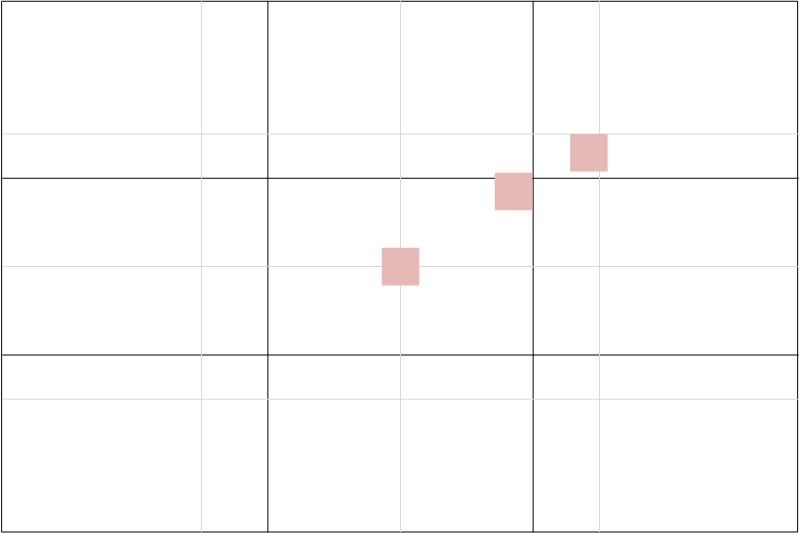









At f/2.8 the sharpness in the center and inner center periphery is completely OK but contrast is low. The outer periphery has the same sharpness but lower contrast. Each half stop of smaller aperture gives clearly visible improvements to both sharpness and contrast. As we could see in the MTF chart there is not much decrease in sharpness and contrast from the center to the mid-frame and we can see it here too that sharpness and contrast does not get any worse from center to the inner circle periphery point, which is within the mid-frame circle. But there is some decrease in both contrast and sharpness at the outer periphery circle, which is further away from the mid-frame.
Sharpness (Close-up)
We test the closeup sharpness and contrast only in the center of the image.




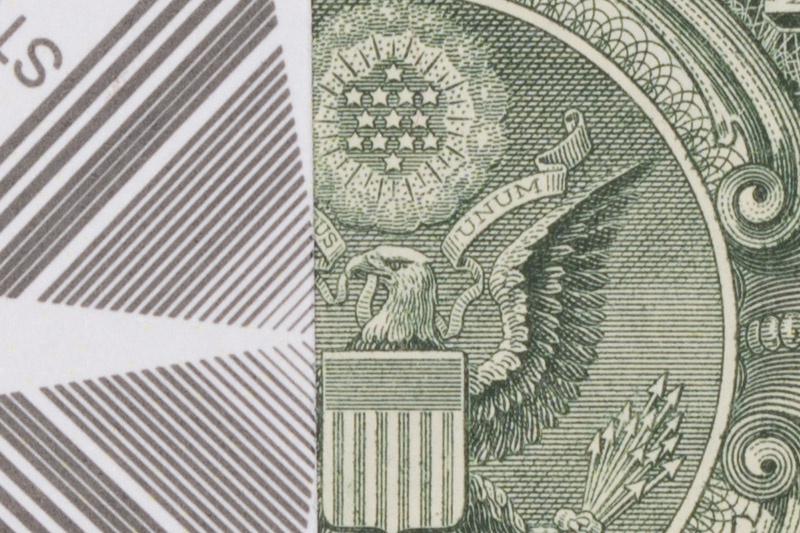


At about the minimum focusing distance the lens is quite soft with low contrast at f/2.8 but usable. At f/4 the sharpness and contrast get a boost to good levels. The lens seems to reach its max performance at F/5.6 and is still very good at f/8. At f/11 the diffraction effect creeps in and degrades the sharpness a little. the sharpness gets another hit at f/16. At f/22 the sharpness falls abruptly to very soft. This is again better than I expected.
Lens Distortion
TTArtisan 100/2.8 has a negligible amount of pincushion distortion, normally there is no need to correct this. This is very good. Also, as this lens’s applications do not require perfect distortion correction, this can just be ignored in almost all use cases of it.

Vignetting
The lens shows very low vignetting. At f2.8 there is only 2/3 of a stop vignetting, which improves to 1/3 of a stop at f/4. Further closing of the aperture does not make much difference. Very good indeed.

Update 16.11.2023
The M-mount version shows stronger vignetting, especially stopped down. Have a look at the product page where this is described and be sure you are okay with it before ordering.
The M version was released several months later than the M42 version, in the beginning of November 2023. The M version has a different vignetting pattern than the M42 version. I have not had that lens to test, but in the following you can see the images TTArtisan themsleves have published regarding this.

Flare Resistance
The lens has, as expected, some problems with flares, it is a very old design and there is no mention of any advanced coating and thereof the lack of flare resistance. Although this has been part of the attraction of this lens for some. Here you can see what to expect if you are not cautious with the placement of sun in or near the image frame unless you want to use the flare creatively.





Chromatic Aberrations
There is not much sagittal chromatic aberration visible in the images. Good performance here but you can clearly see the longitudinal chromatic aberration as green and purple fringing at f/2.8 that reduces by stopping down. At f/5.6 it is cleared up.
Focus Shift
The lens shows positively surprising low to no focus shift to worry about, so it is good.




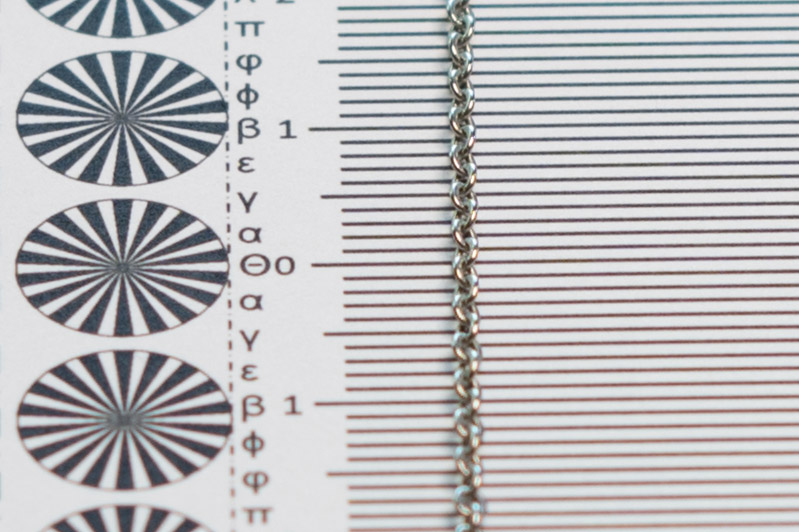
Coma
Testing coma is actually irrelevant for this lens but to be consistent and cover this aspect too, here it is. There is some coma at f/2.8, though not so bad. It improves quickly and a lot by stopping down and is almost gone by f/5.6.




Sunstars
In this category I am a little impressed, not because this lens creates sunstars that can compete with the best sunstars created by some other lenses but because it can create any sunstars at all. I mean, 13 rounded aperture blades are hardly to be expected to be able to create any sunstars worth mentioning, but as a matter of fact this lens manages to do it. It can create sunstars at smaller apertures, 26 pointed versions of them to be more precise. Quite unique or at least very rare actually and maybe not very well defined but nice. 



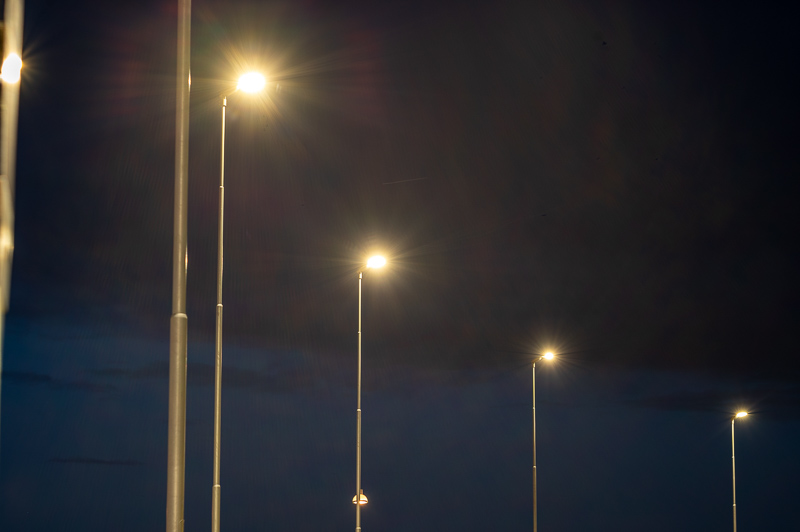


Focus Breathing
Yes, the lens suffers from severe focus breathing.

Bokeh
Well, this must be the main (if not the only) feature of real interest for anybody who reads this article or buys the lens. This lens can indeed create quite interesting bokeh in the right conditions, the soap bubble bokeh. The lens can certainly create one of the best soap bubble bokehs I have seen, if you manage to find those right conditions though. It can even become too much in certain conditions (fourth image in this section), but that is a matter of personal taste. Even if the conditions are not right, the 13 rounded apertures are capable of rendering very soft and pleasant “traditional” bokeh even stopped down a little (the second and third images). Another good feature with the bokeh is that the lens vignetting is not prominent at all so the bokeh balls look equally beautiful, more or less circular without any truncating all over the frame.
Not everybody likes this kind of soap bubble bokeh though but if you do, it certainly can deliver it.


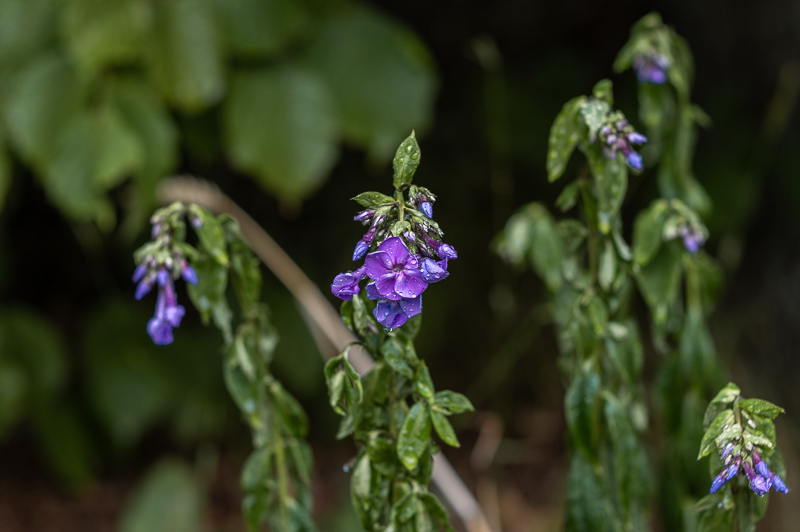

Conclusion
| I LIKE | AVERAGE | I DON’T LIKE |
| Bokeh Price Size Vignetting control |
Center sharpness Aberrations Distortion Sunstars + |
Corner sharpness Across the frame sharpness No electronic contacts for Exif |
This is a special purpose lens and not a lens for everyday photography. A lens with an optical construction from over 100 years ago, used over 65 years ago in a lens with the same focal length, same max aperture, and even a look that resembles a lot that old lens. It is obvious what TTArtisan wanted to create; a new Trioplan, which has been so popular for its soap bubble bokeh and TTArtisan created this lens mainly to create or mimic that bokeh effect and they have succeeded. With modern manufacturing technology they have created a lens with a very similar effect to (if not better than) the original one. It can not only create the bubble bokeh effect, but also the traditional dreamy soft glowy bokeh for portraits or other creative works, and that with quite good sharpness in the frame center, where it does matter for this lens’s applications. Of course Meyer-Optik Görlitz has also done it and you can buy a new Trioplan 100mm f/2.8 made by them but that one costs around €1000 Euro new, while the TTArtisan 100/2.8 costs only $155 in their own online store, which reflects the actual value of a very simple 3 glass element lens. You can also buy the original Trioplan on eBay, but it will not cost less, and you have no warranty either, besides you buy a 65-year-old lens with glass that was ground with that time’s machines and technology. All in all, if you like this effect, irrespective of the price, I highly recommend this lens, the low and fair price for a new lens is a welcome bonus.
If you are interested in buying this lens or any of the lenses in the Alternatives section, you can support our efforts by using the links below or given under each lens. It won’t cost you a penny and it won’t affect the price, but it will help us a little.
Buy it new: TTArtisan Store for $155 (affiliate link) or $210 for the M-mount version (affiliate link)
Alternatives
This will not be an exhaustive list of all the lenses that can create soap bubble bokeh. It just gives a few alternatives to be considered.
Meyer-Optik Görlitz Trioplan 100/2.8
This is the original lens that created such hype during the new era of photography, the digital era. It can create very nice soap bubble bokeh in the right conditions. You can either the original 45-60 years old ones from about $200-$600 depending on the condition or a brand new one for $999
Buy new: amazon.com for $999 (Affiliate links)
Buy from: ebay.com, ebay.de, ebay.co.uk, ebay.com.au (affiliate links)
Meyer-Optik Görlitz Trioplan 50/2.9
This is the 50mm version of the legendary Trioplan series also with admittedly nice soap bubble bokeh. This is also a lens the new Meyer-Optik Görlitz has revived and can be bought new
Buy new: Amazon.com, Amazon.de, amazon.co.uk, Amazon.fr for $ (Affiliate links)
Buy from: ebay.com, ebay.de, ebay.co.uk, ebay.fr, ebay.com.au (affiliate links)
Meyer-Optik Görlitz Domiplan 50/2.8
Another tiny lens from Meyer-Optik Görlitz with very nice soap bubble bokeh but this one is inferior to the Trioplan 50mm in optical and build quality but possibly the cheapest soap bubble bokeh lens you can find. ($20-$60)
Buy used: ebay.com, ebay.de, ebay.co.uk, ebay.fr, ebay.com.au (Affiliate links)
Meyer-Optik Görlitz Primotar 135/3.5
Yet another Meyer-Optik Görlitz lens with a Tessar design, which can produce beautiful soap bubble bokeh but with a longer focal length if you prefer that, costs about $80-$200 on ebay.
Buy used: ebay.com, ebay.de, ebay.co.uk, ebay.fr, ebay.com.au (Affiliate links)
Meyer-Optic Görlitz Oreston 50/1.8
This is another optically not so good lens, but it can create some kind of painterly bokeh in certain conditions, also this one has just or barely OK center sharpness wide open, the rest of the frame is bad actually. Stopped down it gets better but it should be considered only for its bokeh, especially on APS-C cameras.
Buy from: ebay.com, ebay.de, ebay.co.uk, ebay.com.au (affiliate links)
Pentacon 50/1.8
This is actually the same lens as the aforementioned lens. When Meyer-Optik Görlitz and Pentacon merged, they decided to keep the Pentacon name for the company and their products. Then they re-badged the Oreston and sold exactly the same lens as Pentacon 50/1.8. As these ones are newer, after a couple of years the lenses got multi-coating, which gives the later version an advantage over the earlier ones and the Oreston lenses.
Buy from: ebay.com, ebay.de, ebay.co.uk, ebay.com.au (affiliate links)
More Sample Images










Most of the sample images in this review and many more can be found in higher resolution here.
Further Reading
- Review Of The Overhyped Meyer Trioplan 100mm 1:2.8
- Review: Meyer-Optik Görlitz Domiplan 50mm 2.8
- Review: Olympus Om Zuiko Auto-T 100mm 1:2
- Review: Minolta Md 100mm 1:2.5
Support Us
Did you find this article useful or just liked reading it? Treat us to a coffee!
![]()

(Donations via Paypal)
Buy this lens from: TTArtisan Store for $155 (affiliate link) or $210 for the M-mount version (affiliate link)
This site contains affiliate links for which I may receive a small commission if you make a purchase via the links at no additional cost to you. This helps support the creation of future content.










Its already sold out. Are there comming more?
According to their Instagram page it will be available to buy at 6:00 pm UTC/GMT+8:00 which should be German 12:00 noon.
I added a note in the article to make this clearer.
As always, a great presentation of a lens.
I own the Meyer-Optik Görlitz Domiplan 50/2.8 you mentioned, it rarely gets used but sometimes I like the bubble effect. A 100mm lens with the effect would appeal to me more, but I wasn’t willing to spend that much money on a new Trioplan or used Trioplan from the 60s , I would use it too little for that. But for under 200 € I will probably become weak.
thanks Stefan.
TTartisans recommand an Adapter with adjustable centerline.
Where do I get this for Leica-m?
This one should work: https://amzn.to/44VicQx
With the small screws on the side you can loosen the silver part holding the lens.
You only need to rotate it to the desired position and tighten the screws again.
Super lens and test. Good price.
Uniwersal mount.
Thanks Marek.
M42 is an interesting choice and I might buy it just for that. I have been shooting my old Pentax Spotmatic F lately and I like the idea of a new lens for it. Thanks for the review!
Thanks Richard.
Thanks for the introduction and review of this lens! I immediately ordered mine! 🙂
The price seems to be a bargain – even if i take some additional toll into account when importing to germany.
Thank you Michael.
Vielen Dank für diesen sehr ausführlichen Beitrag, das Objektiv ist bestellt … könntest du einen passenden Adapter für das Sony System empfehlen?
Danke für die Hilfe und Beste Grüße
Hallo Jeanette, du könntest zum Beispiel den hier nehmen: https://amzn.to/47oQBJd
Nice review. Interesting lens. HI I would highly recommend the Fujinon 55 mm f2.2 ( 5 -20 Euro) it is a Unar design with 4 lenses in 4 groups with soap bubble and its much sharper especially close up. Also great for UV-photography, I expect that the TT-artisan might perform in that area quite well so I’m curious to test that. Other lenses with soap bubble bokeh. Nikkor AFD DC (Defocus control) 105 mm f2 6/6 design. I own this as well, very nice soap buble when you turn the DC control ring to F. In the neutral position its sharp and contrasty from f2.8 onwards. Very versitile lens. But 2nd hand you’ll pay 600 Euros. The same applies for the 135 mm f2 DC lens. Both have AF on a D750/D800 body et cetera.
Many thanks Björn,
I should definitely test your suggested lenses an will do so as soon as there is an opportunity.
I see your review shows you used this lens on a Nikon Z – What about Nikon F Mount and adaptor for M42 – I have several vintage M42 mounts and on Nikon F you cannot get infinity focus. Is this the case with this TTArtisan lens – there is no mention of this on their website. Thanks Martin.
No M42 lens can reach infinity on Nikon F because the flange focal distance of Nikon F is longer than of M42.
This TTArtisan lens is no exception.
Thanks – I thought so. too bad they don’t have a choice of mounts, but I assume that would possibly drive up cost.
The only way is to use an adapter with an additional lens. But they are expensive and don‘t work well with every lens. The lens in the adapter can influence the sharpness and the Bokeh of the M42 lens.
The most normal kind of adapters that are required for using M42 lenses on other mounts, usually do not have any lens inside, they are just hollow tubes that should not have any negative impact on the lens’s optical quality.
Yes, it is a limitation and disadvantage of M42 lenses on Nikon F mount, it can in many cases be a deal breaker for a Nikon F camera owner. But think where and for what kind of photography you will use the lens. The infinity sharpness is crucial for e.g. landscape photography, but for flower and/or portrait photography, as a couple of examples, the lens is not used at infinity. This specific lens is popular for its bubble bokeh, that effect will never happen when the lens is used at infinity. So if anybody buys this lens for the soap bubble bokeh, which is the only reason anybody should buy it for, will normally not buy it to use it at infinity, so after all maybe it’s not a show stopper for this specific lens. I have actually one sample image taken with a F mount camera in the review article.
I have several vintage lenses with M42 (Helios and Meyer optiks). You are correct about the flange distance on Nikon F mounts with no infinity focus. Any adapters that claim to give you infinity by adding glass don’t work. You can focus out a few feet with a regular adapter (depending on lens), so they are ideal for flowers and macro. But one other thing to consider for more macro use, is adding an extension tube (minimum focus distance is about 3 feet on my vintage lens) and that’s not close enough to fill the frame with a subject like flowers…using an ext tube brings your focus nearer but also changes the bokeh somewhat (depending on whats there) but still beautiful. I have many images on my IG page showing the bokeh with meyer optic trioplan 100 taken with my Nikon D750 and assume this lens would work the same and probably better because my old Meyer Optik is slightly soft. I see your sample with D7200, which is a nice example showing the flower (probably at min focus distance) but enough background to render the bubble bokeh – so my thoughts are this could really be promoted as such, even with Nikon F mounts. I’d love to test it to compare because $1000 is too steep for the new Meyer Optik 100 and vintage are rarer by the day plus expensive.
Bonjour
J’ai un 85mm 1.5 Helios en M42 mise au point maxi 4metres sur un nikonF (D610) mais pour faire du portrait avec un beau flou d’arrière plan (bokeh) cela convient très bien.
Avec un 100mm en M42 vous devriez avoir un lise au point maxi vers 4m50
Amusez vous!
Hej Alain,
Ja, Helios 85/1.5 är ett annat gammalt fint objektiv som också kan producera fin bokeh.
Ha det så kul med det!
Hoppas du finner våra artiklar intressanta.
Mvh
Martin
This lens may be the exception. I noticed my sample “focuses beyond infinity”. Measuring the length with and without M42-E adapter I noticed the difference between these too measurements is more than 1.5mm less than expected. I.e. the lens barrel is too short – which explains why I have to “focus on less than 10m” on the scale (moving the triplet apparently > 1.5mm away from the sensor) to get infinity focus. If I’m correct, the difference between F and M42 FFD is 46.5-45.46 = 1.04mm – which means you have about half a millimetre more of room to play than you need. Unless of course there is sample variation in the lens length ..
That’s not the only thing that makes the TTArtisan M42 lenses “different”. When mounting them on a M42 camera the lens markings may not be on top, which should be the case with all authentic M42 lenses. So, use it with an adapter that can be adjusted for that (most do).
Nice article. Like Gerri, I use the Trioplan 100 mostly with an extention tube, because that’s how you get it to really show the bubbles in my opinion. It would be a treat, if the TTartisans lens could focus more closely.
So what I’m asking is: What’s the minimum focusing distance of the lens?. I assume it’s the (disappointing) 0.9m you can see in one of your photos.
There is a spec sheet right at the beginning stating 0.9 m.
I will probably be getting one in the not to distant future, but in the meantime I have had good luck with my Nikkor-S 50mm F1.4.
It is pretty sharp stopped down, but at f1.4 it can produce nice soap bubbles or busy bokeh depending on taste. Has anyone gotten soap bubbles from an old Nikkor-S 50, or is this unique to my somewhat abused example?
I have a few examples in my flickr album.
https://flic.kr/s/aHBqjAbSVn
Bastian has reviewed that lens and in his sample images you can see a couple with soap bubble bokeh. The bubbles are not as distinct and beautiful (to my taste) as the ones from the TTA though.
See Bastian’s review and sample images here:
https://phillipreeve.net/blog/review-nikon-nikkor-s-50mm-1-4/
Thanks Martin. My lens is the SLR version with hills and valleys and 7 aperture blades. I do not know if it has the same optics as the rangefinder version. It seems to produce more pronounced rings but that is very dependent on conditions.
Hi Martin. I finally got a copy of the TTArtisan Trioplan. I mounted the Nikon on my Lumix GX85 and the TTArtisan on my Sony R3. This gives similar effective 100mm F2.8 for both cameras. They both produce soap bubbles in similar conditions, but you are correct the TTArtisan bubbles are more distinct.
Which Nikon did you mount on your Lumix GX85? (I don’t recall I compared it with any Nikon)
Nikkor-S auto 50mm F1.4. F mount 1125381. I had mentioned it produced soap bubbles at the start of this sub thread. I should have repeated it for clarity.
Hello
1000$ for a new Meyer Optik is too expensive!!!
300 to 600$ for an original Trioplan is hazardous!
I have bought an old trioplan to have a tele for an Exakta Varex but it was before people became crazy about bubble bokeh and I paid about 50$ for it.
Since I used on Nikon D610 it is very interesting for portrait even if maximal focus is about 4m30 4m50.
The price of TTartisan is good considerating it cannot be your one teleobjectif because its particular construction and use
Hello Alain,
Yes, I have an old Trioplan 50mm with Exacta Varex mount too. I paid a little more than you, I need to make review about it soon.
Can add one more alternative for bubbly bokeh – Promura 135mm f/3.5. It’s quite rare, but dirty cheap and makes excellent soap bubbles.
Thanks Stefan, mine arrives in 5 days. I have a Zeiss Batis 85 and the Sony GM 135, this will be an occasional use, but at $155…..
Interesting that the lens is now also out in an M-mount version.
I bought the lens on the strength of this review and am very happy with it. But I have it in the M42 version, and use it on a Sony with a helicoid adapter that offers some very welcome additional functionality: Fully extended, the helicoid adapter reduces the minimum focus distance from 90cm to about 45 cm, or about 29 cm from the front of the lens, and that’s a huge advantage for the M42 version.
Thanks for letting us know the M mount was released! Just ordered one through your link!
I just received my M mount version and it hard vignettes at all apertures. This is surprising seeing your version does not vignette at all.
https://www.flickr.com/gp/39133227@N08/6iq168T8R5
Happens at near or far distance, at all apertures but this shows it the most.
I think it is a “feature” of the M mount version, it is described on their product page:
https://ttartisan.myshopify.com/products/100mmf2-8m?ref=EvdGAnf950qaM
(lower left)
Hi. Nice review. Do you know where to buy M42 to Nikon F adapter?
This adapter does not make a lot of sense as you will not be able to focus at infinity anymore.
Thanks.
M42-Z adapters:
https://amzn.to/3wPBhb0